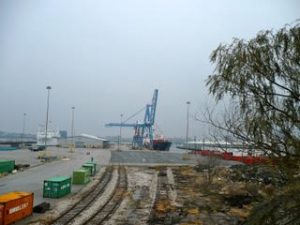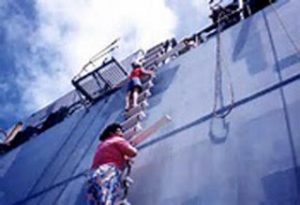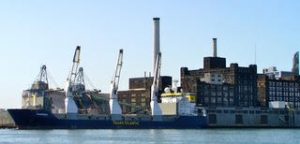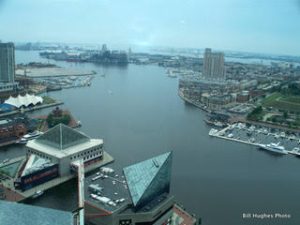My growing up and waterfront days in Baltimore’s Locust Point
In the 1940s, a blacksmith shop was located one block from the harbor at the very foot of the 1100 block of Haubert Street in Locust Point. It was next to the then-thriving Procter & Gamble (P&G) plant, in South Baltimore, now occupied by the bustling Under Armour facility.
First, let’s focus on Klemkowski’s emporium. It catered to the merchant seamen more than it did to the local stevedores. There was some resentment about that. When I was about twelve years old, my first freelance job, circa 1949, was shining shoes in the local bars in my neighborhood, such as Klemkowski’s.

Invariably, the seaman customer would ask me this question: “Do you have any sisters?” My response: “Yea, I do and my dad’s a cop!” That would end that conversation! The shoe-shining gig went no where, plus there was a lot of competition, especially from my neighbor, Frankie “The Greek” Pappas.
I was raised, first, at 1237 Haubert Street – a two-story house. There was no swimming pool in our neighborhood. We all learned how to swim in the murky waters of the harbor, mostly at the foot of Hull Street. No trunks either. We swam in our undies. Somehow we survived the water pollution from the P&G plant. It may have built up our immune system. Who knows?
In grade school, my twin brother Jim and I got a weekly job delivering circulars to homes in Locust Point for a local food market owned by two guys, named Ben and Lou. It didn’t pay well and often the weather was brutally cold or boiling hot. So one day, we decided to dump the flyers down a sewer and instead take in a movie at the Deluxe Theatre on Fort Avenue at Lowman Street.
Putting aside the ethical question, it was a dumb idea! A day or so later, there was a flash flood and all the circulars came spewing-out onto the street! OMG! Since the pay was a joke and the circulars brought in little in the way of new business, nothing happened. In fact, Jim wound up working in the food market. Go figure.

My next job, while in my freshman year of high school, (1951), was delivering the “Baltimore Evening Sun” newspaper to homes in Locust Point for a hefty $2.50 a week! My boss was Louis Gilweiser, a hard-working man, who also enjoyed playing a musical instrument in Baltimore City’s orchestra. Yea, the city had a municipal orchestra back then!
“The Evening Sun” gig lasted about a year and taught me some solid work-related habits. For example, there was lesson # 1: If I didn’t show-up, the newspapers didn’t get delivered!
There were then about twenty taverns in Locust Point. During and just after World War II right until the early 60s, they all made a pretty good living.
Locust Point, then a blue collar bastion, is located on a peninsula which juts out into Baltimore harbor. At its tip was found fabled Fort McHenry. How blue collar was it? There were five International Longshoremen’s Association (ILA) union halls located there, all within walking distance of each other.
Also, in some of the bars on Locust Point, a portrait of John L. Lewis, the hell-raising boss of the United Mine Workers of America would be found proudly hanging on their walls. Locust Point was Union-strong!

For example, my first new car was a 1957 Bel Air, blue/white, sports sedan Chevrolet, with long tail fins. I bought it for about $2,500 from Fox Chevrolet on Hanover Street/Key Highway in South Baltimore. Think “Elvis on four wheels!”
Back to the blacksmith shop! The front gate of it was usually open and you could see the furnace firing away in the back. It was a small building, darkish in color, like something out of Charles Dickens’ London. The owner lived on the second floor of his shop. He was a very private person, short in stature, with a mostly dirty, unshaven face.
Movie buffs may recall the “stevedore hook” from that classic 1954 movie, “On The Waterfront,” starring the late, great actor, Marlon Brando.
You might remember Brando’s famous line from that flick, delivered to Rod Steiger in the back of a car? “I coulda been a contender!”
I recall buying a “hook” in 1955 from the shop. I was then eighteen-years old and I had just joined ILA Local 829. My dad, Richard Patrick “Dick” Hughes, Sr., a boss for the Alcoa Steamship Company, lent me the money to pay the initiation fee – about $180! (Bless your heart, Dad.)
My grandfather, Martin Patrick Hughes, had started the family’s ILA tradition back in the early 1890s. A native of County Mayo, Ireland, he had worked as a coal trimmer in Locust Point. He lived at 1309 Haubert St. The coal pier was squeezed between the P&G plant and the Domino Sugar terminal.
My ILA Local 829 was located on Hull Street, opposite “Buck” Kreps’ bar (nka “The Hull Street Blues”). We were then living a few doors away from from Kreps’, at 1238 Hull Street, in a three-story house.
It didn’t take long for me to get my feet wet as a longshoreman. I was hanging out in the hall playing a friendly card game, when a gang carrier, “Reds” Burdinski, came rushing in.
The cargo we were to work on was located on a barge tied to the ship. It was going to be loaded into the number one hatch of the vessel. The problem for us was getting onto the barge! It was positioned near the bow of ship.

So, when you climbed down the “Jacob’s ladder,” (a rope ladder with wooden rungs), to get onto the barge, your body was literally swinging out there in the wind away from the vessel and over the water. It was a little scary, but we all made it safely aboard the barge.
“Unk” was a naturally funny guy, all five foot six inches of him. He was a confirmed bachelor who lived at home with his aging mother. On a good day, I could only understand every other word he spoke. “Unk” did a lot cursing under his breath, too, as he chewed away from the side of his mouth on his unlit cigar.
“Eagle” and “Hopit” would dig the bejesus out of “Unk,” but were smart enough not to overdo it. He had a hyper-sensitive fault line!
“Unk” was notorious for quitting jobs and telling the boss, no matter how big or tough he was, a la Robert Di Niro, “go f… your self!” If he did quit, his partner “Duke” would be left on his own. Luckily, that didn’t happen.
The time flew by and soon the job, after about three or four hours, was over. Mercifully, we didn’t have go back up that “Jacob’s ladder.” I was glad for that!
A tug boat was there to take the empty barge back. First, it dropped us off at the head of the pier. Then we walked back to the hall, happy to have gotten the work and to have survived that “Jacob’s ladder!”
There was another job on the docks that I won’t soon forget. It was at the Davison Chemical Company’s pier in Curtis Bay in South Baltimore. Davidson is a division of the W.R. Grace Co.
Kelly and I, along with six other men were laboring in the hole of the ship. Think ultra-humid, like the heat you feel when you get off a plane in Phoenix, AZ. After working under those conditions for a while, I understood why those cowboys out West could be so bad-tempered and quick on the trigger of their gun.

We started at 8 am. Somehow, I survived that grueling day, which ended around 5 pm. We did get an hour off for lunch. You are so exhausted by that kind of work, that even talking is cut to a bare minimum. Later, I would ride by that Davidson Chemical site and think to myself: “Thank you Lord for surviving that one!”
Fast shift to the other extreme – a winter freeze! After a few years catching p/t jobs out of Local 829 and ILA Local 953 (the Checker’s Union), I went to work for my dad, at pier 9, N/S, Locust Point, where the Alcoa Steamship Line vessels docked. It was a steady gig.
I was a receiving clerk and had to join ILA Local 1429. My duties were checking the cargo that came into the pier by trucks or rail for loading onto the vessels.
One winter night, we had to drive about 100 jeep vehicles onto the pier for the longshoremen to load on an Alcoa ship. The holding area for the jeeps was about a quarter a mile from the vessel. It was below freezing and windy and we were in an exposed area.
Paul Hutchins, now deceased, was one of my co-workers. I weighed then about 150 pounds soaking wet. While, Mr. Hutchins (his son by the same name was a noted “Baltimore Sun” photographer), came in around 120 pounds. He was as thin as a rail. After about thirty minutes, I thought we’re not going to last!

“The Port of Baltimore/Locust Point in Background via a View from the World Trade Center”
Fortunately, wiser heads decided to re-assign some workers from another area to give us some relief. That saved the day and gave us a chance to “warm-up” between drives to and from the pier.
I didn’t realize until much later that my work experiences on the docks (1955-60), would mark the end of an era on the waterfront. The “stevedore’s hook” would soon, too, become part of labor and maritime history.
This meant, too, that all of those colorful characters that I knew from my ILA Local 829 days would also soon recede into fond memories of that bygone period. I moved out of Locust Point in the late 70s. Baltimore City is still my home today.
Editor’s Note: A shorter version of this article was previously published in the popular zine, “Smile, Hon, You’re in Baltimore.”

Bill Hughes is an attorney, author, actor and photographer. His latest book is “Byline Baltimore.” It can be found at: https://www.amazon.com/William-Hughes/e/B00N7MGPXO/ref=dp_byline_cont_book_1
